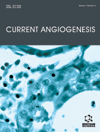-
s Effects of Diet-Derived Molecules on the Tumor Microenvironment
- Source: Current Angiogenesis (Discontinued), Volume 1, Issue 3, Sep 2012, p. 206 - 214
-
- 01 Sep 2012
Abstract
It is now widely accepted that tumors are a complex tissue composed, in addition to the cancer cells, by endothelial cells and their precursors, stromal cells, pericytes, smooth muscle cells, fibroblasts, myofibroblasts. Inflammatory and immune cells such as macrophages, neutrophils, granulocytes, mast cells, B and T cells, natural killer (NK) and dendritic cells also infiltrate the tumor to constitute the microenvironment. All these players interact with each other and with tumor cells through specific molecular pathways resulting in the production of an intricate network of molecular mediators, cytokines and growth factors providing the proper conditions for tumor maintenance, growth and propagation. Several pathways of cell-cell interactions within the microenvironment have been previously investigated and extensively studied in physiological and pathological scenarios. Some of these pathways can be targeted with therapeutic drugs during tumor progression. However, a more efficacious approach would be to halt tumor-host interactions before a cancer develops or metastasizes. Many phytochemicals and diet derivatives are able to act as chemopreventive agents, targeting the tumor microenvironment and in particular inflammatory angiogenesis, in a new discipline that we named “angioprevention”. In this review we analyze some of the potential phytochemical drugs, natural or synthetic, that seem to owe part of their chemopreventive potential to their action on the tumor microenvironment. In particular, we provide an overview of the pathways regulated by chemopreventive microenvironment-active substances: oleanic acid triterpenoids (CDDOs), resveratrol, epigallocathechin gallate (EGCG), xanthohumol and curcumin.


